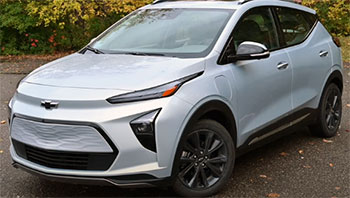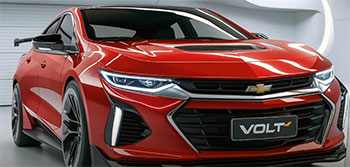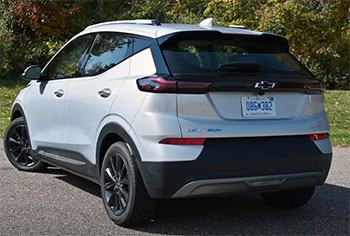When I set out to compare the Chevrolet Bolt EV and Chevrolet Volt, my goal was to understand what makes these two electrified vehicles tick and which one might suit your driving needs better. As someone who’s driven both, I’ve experienced their strengths and quirks firsthand, from zipping through city streets to tackling longer road trips. This article breaks down their differences, weighing performance, range, design, and more to help you decide which Chevy fits your lifestyle. With a conversational yet analytical lens, I’ll share my journey and insights to guide your choice.
Comparison Table: Chevrolet Bolt EV vs. Chevrolet Volt
| Feature | Chevrolet Bolt EV | Chevrolet Volt |
|---|---|---|
| Powertrain | Fully electric (EV) | Plug-in hybrid (PHEV) |
| Electric Range | 259 miles (EPA-estimated, 2023) | 53 miles (EPA-estimated, 2019) |
| Total Range | 259 miles | 420 miles (electric + gas) |
| Horsepower | 200 hp | 149 hp (combined) |
| Torque | 266 lb-ft | 294 lb-ft |
| 0-60 mph | ~6.5 seconds | ~8.4 seconds |
| Charging Time (Level 2) | ~7 hours (240V, 65 kWh battery) | ~2.3 hours (240V, 18.4 kWh battery) |
| DC Fast Charging | Up to 55 kW (~100 miles in 30 min) | Not available |
| Starting MSRP | $26,500 (2023) | $33,520 (2019) |
| Cargo Space | 16.6 cu. ft. (57 cu. ft. max) | 10.6 cu. ft. (less with seats folded) |
| Seating Capacity | 5 (more spacious rear) | 5 (cramped rear due to battery hump) |
| Body Style | Subcompact hatchback/crossover | Compact hatchback/sedan |
My Experience With the Chevrolet Bolt EV
When I first slid behind the wheel of the Chevrolet Bolt EV, I was struck by its unassuming yet futuristic vibe. It’s a subcompact hatchback that blurs the line between a car and a crossover, with a taller stance that gives it a bit of SUV swagger.
Driving it through my city’s congested streets felt effortless—its 200 horsepower and instant 266 lb-ft of torque made it zippy, darting through traffic like a go-kart with a mission. The Bolt EV’s one-pedal driving mode, which uses regenerative braking to slow the car when you lift off the accelerator, was a game-changer for stop-and-go traffic. It’s like the car anticipates your moves, making urban commutes less fatiguing.

On a weekend trip out of town, the Bolt’s 259-mile EPA-estimated range (2023 model) gave me confidence.
I didn’t need to obsess over finding a charging station for my 150-mile round trip, though I did plan to use a Level 2 charger at home for an overnight top-up.
The 10.2-inch touchscreen was intuitive, seamlessly integrating Apple CarPlay and Android Auto, keeping me connected without fuss. However, the ride quality was a bit firm, especially on rough roads, and the interior materials felt a tad cheap for a car starting at $26,500. Still, the Bolt EV’s spacious cabin and surprising cargo room (16.6 cubic feet, expanding to 57 with seats folded) made it practical for my gear-heavy outings.
What stood out most was the Bolt’s zero-emission purity. Knowing I was driving without burning a drop of gasoline felt empowering, especially as gas prices crept up. The Bolt EV’s nimble handling and quiet operation made it a joy for daily driving, though I wished for faster DC charging (capped at 55 kW) for longer journeys. Overall, it’s a car that feels like a practical step into the electric future, balancing affordability with solid range and tech.
Pros Of the Chevrolet Bolt EV
- Impressive electric range: The Bolt EV’s 259-mile EPA-estimated range (2023 model) is a standout, outpacing competitors like the Nissan Leaf (237 miles in testing) and making it ideal for daily commutes and moderate road trips without range anxiety.
- Peppy performance: With 200 horsepower and 266 lb-ft of torque, the Bolt accelerates from 0-60 mph in about 6.5 seconds, offering quick, responsive driving that feels lively in city traffic or on highway merges.
- Affordable pricing: Starting at $26,500 (2023), the Bolt EV undercuts many EVs, and its eligibility for a $7,500 federal tax credit makes it one of the most budget-friendly electric options.
- Spacious interior: Despite its compact footprint, the Bolt offers 44.3 inches of front legroom and 36 inches in the rear, plus 16.6 cubic feet of cargo space, expandable to 57, making it practical for families or gear.
- Advanced tech features: The 10.2-inch touchscreen with wireless Apple CarPlay/Android Auto, a six-speaker audio system, and available Bose upgrade keep you connected and entertained effortlessly.
- One-pedal driving: This feature simplifies city driving by using regenerative braking to slow the car, reducing brake pedal use and making traffic less stressful while boosting efficiency.
- Zero tailpipe emissions: As a fully electric vehicle, the Bolt produces no emissions, appealing to eco-conscious drivers looking to reduce their carbon footprint.
- Nimble handling: Its low center of gravity and compact size make the Bolt agile in urban environments, easy to park, and fun to drive on twisty roads.
Cons Of the Chevrolet Bolt EV
- Firm ride quality: The suspension struggles to absorb road imperfections, leading to a jarring ride on potholed or uneven surfaces, which can detract from comfort on longer drives.
- Slow DC fast charging: Capped at 55 kW, the Bolt’s fast-charging speed (100 miles in 30 minutes) lags behind rivals like the Hyundai Ioniq 5, making long-distance travel less convenient.
- Basic interior materials: The cabin uses hard plastics that feel budget-oriented, lacking the premium feel of pricier EVs, which might disappoint buyers expecting more refinement.
- Limited rear headroom: At 37.9 inches, rear headroom is tight for taller passengers, especially compared to the Bolt EUV’s slightly roomier design.
- No adaptive cruise control in base model: This useful feature is only available as an option, unlike the Volt, which offered it on higher trims, limiting hands-free driving convenience.
- Discontinuation concerns: GM halted Bolt production in late 2023, raising questions about long-term support, parts availability, and resale value, despite plans for a future redesign.
- Battery recall history: Early models (2017-2019) faced fire risk recalls, requiring software updates to cap charging at 90%, which could concern buyers of used Bolts.
My Experience With the Chevrolet Volt

The Chevrolet Volt, a plug-in hybrid (PHEV), was a different beast when I drove it. Its sleek, sedan-like design felt more conventional than the Bolt’s quirky hatchback vibe, blending in with cars like the Chevy Cruze.
The Volt’s powertrain—a 1.5-liter gasoline engine paired with two electric motors—delivered 149 horsepower and 294 lb-ft of torque, making it feel torquey but less sprightly than the Bolt, with a 0-60 mph time of about 8.4 seconds.
Its electric-only range of 53 miles (2019 model) was perfect for my daily 40-mile commute, letting me drive on pure electricity most days. When the battery depleted, the gas engine kicked in seamlessly, extending the range to 420 miles.
I loved the Volt’s flexibility. On a 200-mile weekend trip, I didn’t worry about charging stations—just filled up the 8.9-gallon tank and kept going. The interior felt more polished than the Bolt’s, with a conventional layout and a mechanical shifter that made it feel like a “normal” car.
However, the rear seat was cramped, with a T-shaped battery pack creating a hump that made the middle seat unusable. Cargo space was tight at 10.6 cubic feet, and folding the seats didn’t help much. The Volt’s 7-inch touchscreen (upgradable to 8 inches) felt dated compared to the Bolt’s, and the lack of DC fast charging meant longer stops for recharging.
The Volt’s hybrid nature was both its strength and its complexity. It offered peace of mind for long drives but required gas station visits, unlike the Bolt’s all-electric freedom. Maintenance felt more involved due to the gas engine, and the higher starting price ($33,520 for 2019) stung. Still, the Volt’s ability to switch between electric and gas made it a practical bridge for those hesitant about fully electric driving.
Read More: My Thoughts On Ford Escape Vs. Mazda CX-5
Pros Of the Chevrolet Volt
- Extended total range: With a 53-mile electric range and 420 miles total using the gas engine, the Volt eliminates range anxiety for long trips, perfect for drivers without reliable charging access.
- Hybrid flexibility: The ability to run on electricity for short commutes and switch to gas for longer drives makes the Volt versatile for varied lifestyles.
- Smooth powertrain transition: The shift from electric to gas mode is nearly seamless, with the 1.5-liter engine acting as a generator to keep the ride smooth.
- Torquey performance: Delivering 294 lb-ft of torque, the Volt feels punchy off the line, especially in electric mode, making city driving engaging.
- Conventional design: Its sedan-like styling and traditional cabin layout appeal to drivers who prefer a familiar car feel over futuristic EV designs.
- Fuel efficiency: With 106 MPGe in electric mode and 42 MPG in gas mode, the Volt saves on fuel costs compared to traditional gas vehicles.
- Available adaptive cruise control: Higher trims offer this feature, enhancing highway driving comfort, a feature not standard on the Bolt’s base model.
- Lower maintenance for EV mode: When driven primarily on electricity, the Volt requires less maintenance than a typical gas car, though not as low as the Bolt.
Cons Of the Chevrolet Volt
- Limited electric range: The 53-mile electric-only range is modest, forcing reliance on gas for longer trips, which undermines its eco credentials compared to the Bolt.
- Cramped rear seating: The T-shaped battery pack creates a center hump, making the rear middle seat unusable and reducing legroom to 35.7 inches.
- Small cargo space: With just 10.6 cubic feet of trunk space, the Volt lags behind the Bolt and even some subcompact hatchbacks like the Kia Rio.
- No DC fast charging: Lacking a DC port, the Volt relies on slower Level 1 (13 hours) or Level 2 (2.3 hours) charging, limiting road trip convenience.
- Discontinued model: Production ended in 2019, raising concerns about parts availability and resale value, especially for used buyers.
- Complex maintenance: The dual powertrain (gas and electric) requires more maintenance than a fully electric vehicle, increasing long-term costs.
- Higher starting price: At $33,520 (2019), the Volt was pricier than the Bolt, with fewer federal tax credit benefits as credits phased out by 2020.
- Dated infotainment: The 7-inch touchscreen (8-inch optional) feels small and less intuitive compared to the Bolt’s 10.2-inch display, lagging in connectivity.
Analyzing the Key Differences
Driving the Bolt EV and Volt back-to-back revealed their distinct personalities. The Bolt EV is a pure electric vehicle, relying solely on its 65 kWh battery to deliver 259 miles of range. Its 200-hp motor and instant torque make it feel like a sprightly urban warrior, perfect for those committed to zero-emission driving. The Volt, a plug-in hybrid, blends a 18.4 kWh battery with a 1.5-liter gas engine, offering 53 miles of electric range before switching to gas for a total of 420 miles. This makes the Volt a safety net for drivers wary of charging infrastructure.

The Bolt’s design leans toward a crossover-like hatchback, with a taller roofline and more interior space—44.3 inches of front legroom and 16.6 cubic feet of cargo.
The Volt, styled like a sleek sedan, sacrifices rear legroom (35.7 inches) and cargo (10.6 cubic feet) due to its battery layout.
The Bolt’s one-pedal driving and faster acceleration (6.5 seconds to 60 mph) outshine the Volt’s 8.4-second sprint, but the Volt’s hybrid setup means you’re never stranded, unlike the Bolt, which requires planning for charging.
Charging is another key differentiator. The Bolt supports DC fast charging (55 kW, adding 100 miles in 30 minutes), while the Volt is limited to Level 2 (2.3 hours for a full charge) or Level 1 (13 hours). However, the Volt’s smaller battery charges faster for short electric trips.
Price-wise, the Bolt’s $26,500 starting MSRP (2023) undercuts the Volt’s $33,520 (2019), and the Bolt qualifies for a $7,500 tax credit, unlike the Volt, whose credits phased out by 2020.
Tech-wise, the Bolt’s 10.2-inch touchscreen and wireless connectivity feel modern, while the Volt’s smaller display and older interface show its age. Safety features are comparable, with both earning IIHS Top Safety Pick ratings, offering forward collision warning, lane-keeping assist, and OnStar. However, the Volt’s available adaptive cruise control gives it a slight edge for highway commuters.
Real-World Driving Scenarios
On my daily 40-mile commute, the Volt was a champ, running on electricity alone and charging overnight on a 240V Level 2 charger. I rarely needed gas, averaging 106 MPGe, which saved me money compared to a gas-only car. The Bolt, however, was even cheaper to run, with no gas costs and a longer 259-mile range that covered my weekly errands without a recharge. For a 200-mile road trip, the Volt’s gas engine was a lifesaver in areas with sparse chargers, while the Bolt required a 30-minute DC fast charge stop, which wasn’t always convenient due to its slower 55 kW rate.
For city dwellers with access to charging, the Bolt’s range and zero-emission drive make it a no-brainer. But for rural drivers or those with unpredictable schedules, the Volt’s hybrid flexibility shines, letting you refuel at any gas station. The Bolt’s spacious cabin was a boon for carrying friends or gear, while the Volt’s tight rear seat and trunk frustrated me when packing for a group outing. Both cars handled well, but the Bolt’s lower center of gravity made it more fun on curvy roads, though its firm ride was less forgiving than the Volt’s smoother suspension.
Cost of Ownership and Maintenance
Owning the Bolt EV is generally cheaper. Its all-electric powertrain eliminates gas costs, and with fewer moving parts, maintenance is minimal—think no oil changes or spark plugs. My annual electricity costs for the Bolt were about $500-$700, depending on local rates, compared to $1,200-$1,500 for a gas car with similar mileage. The Volt, while efficient at 106 MPGe in electric mode and 42 MPG in gas mode, still required gas (about $300-$500 annually for my driving) and occasional engine maintenance, like oil changes, which added $100-$200 per year.
The Bolt’s $7,500 federal tax credit (2023) significantly lowers the effective cost, while the Volt’s credits were gone by 2020, making used Volts less appealing unless discounted. However, the Volt’s simpler charging needs (no DC fast charging) mean you don’t need specialized home equipment, though a Level 2 charger ($500-$1,000 installed) is ideal for both. The Bolt’s battery recall history (2017-2019 models) is a concern for used buyers, but GM’s software fixes and warranty (8 years/100,000 miles) mitigate risks. The Volt’s dual powertrain increases long-term maintenance complexity, potentially raising costs as the car ages.
Environmental Impact and Lifestyle Fit
As an eco-conscious driver, the Bolt EV’s zero tailpipe emissions were a major draw. It aligns with a fully electric lifestyle, especially if you charge with renewable energy. The Volt, while greener than a gas-only car, still emits CO2 in hybrid mode, producing about 1.5 tons less CO2 annually than a 30 MPG gas car for 12,000 miles driven. For urbanites with short commutes and reliable charging, the Bolt is ideal. For those in areas with limited chargers or who take frequent long trips, the Volt’s gas backup offers unmatched flexibility.
The Bolt suits tech-savvy drivers who embrace EV infrastructure and plan trips around charging. The Volt fits those transitioning from gas cars, offering a familiar driving experience with electric benefits. I found the Bolt’s modern cabin and range empowering for city life, but the Volt’s ability to “just keep going” on gas was reassuring for spontaneous adventures.
Read More: My Thoughts On GMC Terrain Vs. Ford Escape
Frequently Asked Questions (FAQ)
The Bolt EV is better for urban drivers with access to charging, offering 259 miles of range and zero emissions. The Volt suits those needing flexibility for longer trips, with its 420-mile total range. Your choice depends on charging access and driving habits.
GM discontinued the Bolt EV and EUV in late 2023 to focus on newer Ultium-based EVs like the Equinox EV. Despite strong sales, GM aimed for vehicles with advanced battery tech, though a redesigned Bolt is planned.
No, the Bolt EV is a fully electric vehicle with a 259-mile range, while the Volt is a plug-in hybrid with 53 miles electric and 420 miles total using gas. They differ in powertrain, range, and design.
The Volt has a limited 53-mile electric range, cramped rear seating, small 10.6 cu. ft. trunk, no DC fast charging, complex maintenance due to its dual powertrain, and was discontinued in 2019, raising resale concerns.
Conclusion: For the Chevrolet Bolt EV and Volt
You’re now equipped to choose between the Chevrolet Bolt EV and Volt, and I hope my experiences have clarified what each offers. If you’re an urban driver with reliable charging, the Bolt EV’s 259-mile range, peppy performance, and $26,500 price tag make it a compelling, eco-friendly choice. If you need flexibility for longer trips or live where chargers are scarce, the Volt’s 420-mile total range and hybrid versatility are hard to beat, despite its $33,520 cost and dated tech. Consider your driving habits, budget, and access to charging to pick the Chevy that powers your journey.

